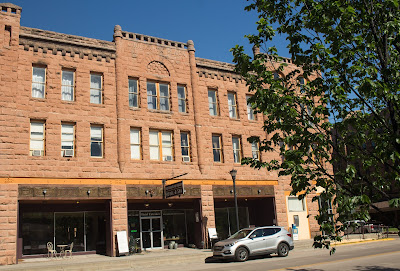A late morning start and a 90-minute drive took us to
Wounded Knee, back on the Pine Ridge Reservation.
We spied these two horses as we sped toward Wounded Knee. I think you'll agree, they were worth turning around for!
We hadn’t even parked our
car, before being accosted by a couple of Lakota trying to sell their wares.
The man was particularly aggressive, thrusting a Chamber of Commerce
publication into my hands and saying the Starbucks and Wal-Mart were just up
the road. Sue and I both thought that was a rather odd remark, but said
nothing. He kept handing me beaded trinkets, and the woman standing to his
side, her hands full of similar items, finally challenged me, saying “You’ll look
at his stuff and not mine?”
Both readily backed off when I told them I’d take a look
at their wares after I’d done what I’d come for.
They were probably anxious to get their tourist season started.
Sue and I evidently were the first tourists of the day.
We stopped to read two large signs that explained the
events leading up to the Wounded Knee Massacre.1 The man kept
interrupting our reading, wanting to talk. His talking was not entirely
unwelcome, though. He reminded me of an event I’d all but forgotten: the 1973
standoff at that site.2
But I wanted to see if I could feel anything at Wounded Knee, the way I’d felt something profound at Culloden, in Scotland. And the two sites are similar, in that both were sites of harsh treatment meant to completely crush rebellion against an unwanted occupier – and both spelled the end of their respective native cultures.
The field was unkempt and full of crushed beer cans and other waste. I found myself wishing that the National Park Service had overseen this place. Surely they would keep it more pristine, so that it would be more possible to study and reflect.
But Wounded Knee does not belong to the US; it belongs to the Lakota, and I suppose it’s their right to make of it what they will. It was, after all, white men imposing their vision on red men that led to the Wounded Knee Massacre.
But Wounded Knee does not belong to the US; it belongs to the Lakota, and I suppose it’s their right to make of it what they will. It was, after all, white men imposing their vision on red men that led to the Wounded Knee Massacre.
I bought a beaded necklace from each, the man and the
woman, and I know from what each said to us that they were sorry to have judged
us as tourists who were just “bagging” historical sites by spending a couple of
minutes, buying souvenirs, taking a selfie, and then heading to the nearest
Starbucks.
Fearing another pushy encounter with a different jewelry vendor, Sue and I did not choose to view the massed burial site at the top of a nearby hill; instead, we went to Porcupine – just for the name!
Fearing another pushy encounter with a different jewelry vendor, Sue and I did not choose to view the massed burial site at the top of a nearby hill; instead, we went to Porcupine – just for the name!
Then we took an unpaved road through agricultural areas (once again, riding around off the map on Native American land!), to finally catch the road back to Hot Springs.
Along the route, I spied a Baptist church and wondered if it might be the church where my parents had done some mission work, years ago.
Stopping in the actual town of Pine Ridge, we grabbed a quick bite at the West’s ubiquitous Mexican fast-food joint, Taco John’s. Hey, isn’t it important to experience local flavors and customs? No one says you have to experience it ever again, right?
Stopping in the actual town of Pine Ridge, we grabbed a quick bite at the West’s ubiquitous Mexican fast-food joint, Taco John’s. Hey, isn’t it important to experience local flavors and customs? No one says you have to experience it ever again, right?
We took a look around the resort town of Hot Springs,
which seemed as if it were waiting to awaken for tourist season.
This charming depot greeted many a visitor to Hot Springs, back in the day.
The hotel right across from the depot. Notice the name, up high on the building: Minnekahta, the Lakota word for "warm water." Minnekahta was regarded as a sacred site to the Lakota and the Cheyenne; the town was renamed Hot Springs in the 1880s.
Hot Springs boasts an impressive "collection" of sandstone buildings ...
... and this lone art-deco theater.
Braun Historic Hotel, just north of the downtown on the Fall River. Check out the Filet Mignon price!
Then we visited the very impressive Mammoth Dig Site. Here,
a large building actually covers the active dig of an ancient sinkhole, discovered
entirely by accident in 1974. The site was being prepared for a housing
development, when a bulldozer unearthed part of a Woolly Mammoth skeleton. The
original building project was called off and the paleontologists called in.
It’s fascinating to see how a dig works!
Comparing the sizes of various mammoths, which you've never seen before, to the African Elephant, which you have.
Reconstruction of a Columbian Mammoth, the biggest of all the mammoths. He was SO HUGE, I was standing as far away from him as I possibly could, with my camera zoomed out as far as it would go, and yet this is as much of him as I could capture.
We finished the day with dinner at The Woolly, next door to the dig, which seems to be a favorite of locals.
2https://en.wikipedia.org/wiki/Wounded_Knee_incident
More photos from the Forces of Nature Tour at Flickr.
Click here.
More photos from the Forces of Nature Tour at Flickr.
Click here.























No comments:
Post a Comment